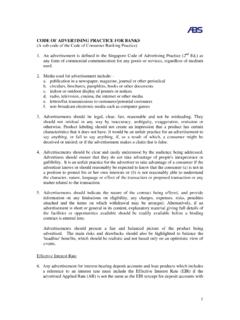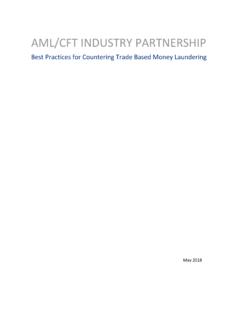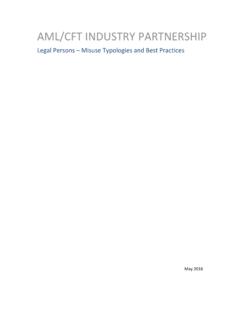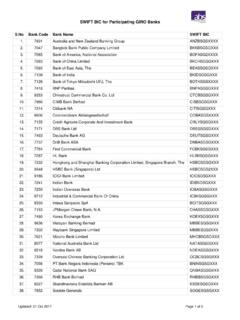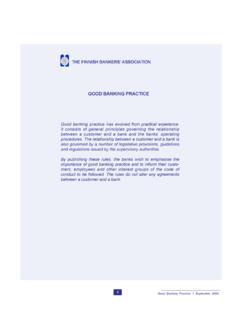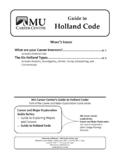Transcription of Code of Banking Practice - Unsecured Credit - ABS
1 1 code OF Practice FOR BANKS Unsecured Credit Guidelines For Individuals with Annual Incomes of between $20,000 and $30,000 (A sub- code of the code of Consumer Banking Practice ) 1) Introduction Following MAS Notice 635 of 25 February 2009 which lowered the income of individual borrowers eligible for Unsecured Credit to $20,000 per annum, the Association of Banks in Singapore has drawn up guidelines for banks wishing to develop the market for customers with annual incomes of between $20,000 and $30,000.
2 These guidelines aim to ensure a more consistent regime in granting of Unsecured Credit by banks. Customers in this income segment need an affordable and reliable source of Credit but until 1 March 2009, banks were not permitted to provide them with Unsecured Credit . Banks have a good understanding of this market segment, including the operating and competitive environment, the risk profile and behaviour patterns of borrowers as well as the legal framework within which the business is to be conducted. Banks are mindful of the needs associated with this income segment and will adopt prudent measures when granting Credit to these customers.
3 2) Types of Products to be Offered Banks will offer Credit facility of up to 2 times the monthly income of the borrower in the form of a: i) revolving Credit facility with minimum monthly repayments; or ii) term loan with monthly instalments to be repaid over a fixed tenor. This is to cater to the different financial needs of individual customers. 3) Account Maintenance Temporary line increases shall not be offered to borrowers who opt for the revolving Credit facility 4) Product Acquisition a) Marketing / sales / advertising material and sales staff will provide transparent and clear communication on: i) monthly instalment amount for term loan and minimum repayment amount for revolving Credit facility so that an applicant would know his commitment in advance and whether he could afford the repayment; ii) product features.
4 2iii) interest rate; iv) penalty interest rate for non-repayment; v) effective interest rates (EIR); vi) fees and charges (sign up fee, annual fee, late fee, excess charges, cancellation fee and pre-payment fee). b) Banks will not over-incentivise sales or push the product; c) Banks will by way of their approval policy/process or in the product collateral/ communication: i) Provide information on what the loan can be used for; ii) Stress capacity to repay the loan; iii) Specify minimum monthly repayment amount required; iv) Highlight to the borrower, his individual Unsecured borrowing limits with the banks; v) Stress the importance of maintaining good repayment behaviour and Credit history; vi) Spell out terms and conditions, fees and charges of the Credit facility.
5 Vii) Be aware of the importance for borrowers to provide written acknowledgement that they have read and understood the terms and conditions of the Credit facility; d) Telemarketers will adhere to 'Telemarketing Guidelines for the Financial Industry' and be clear and transparent on the purpose of their call. 5) Credit Evaluation Banks will exercise prudent lending in adopting the following criteria: a) Unsecured Credit Facilities i) Credit worthiness of borrower - banks should conduct a comprehensive check of the overall indebtedness and creditworthiness of the borrower using available internal and external information including Credit bureau records; ii) Assess stability of job and income stability; iii) Verify employment; iv) Upload Credit data to Credit bureau for future reference on the borrower.
6 V) Stipulate minimum prescribed set of documents to be submitted such as identity, income, address proof and other supporting documents; vi) For customers between 18 and 21 years, a guarantor is mandatory for the Credit facility. b) $500 Credit card i) Parental / guarantor consent is required for customers who are below 21 years old; ii) Upload Credit data on borrower to Credit bureau for future Credit checks; iii) Defaulting customers will be prevented from further card usage; iv) No temporary Credit limit increase will be granted on the card. 36) Collections a) Adherence to Laws, Rules and Regulations i) Collection activities undertaken by or on behalf of the creditor bank should at all times conform to all applicable laws, rules and regulations.
7 Ii) All standard forms of communications used by the appointed collection companies or collections department in the Bank ( letters, pre-written scripts or SMS) must adhere to the Bank s standard / Practice ; iii) Borrowers repayment conduct will be reflected in the borrowers Credit bureau report. b) Borrowers to be treated with dignity and respect i) Banks should limit their calls to certain times and places as far as possible. If a message has to be left, it should be limited to the information required for the borrower to return the call; ii) Collections efforts should include providing information on available options in establishing a debt repayment schedule, taking into account each borrower s financial situation; iii) Collectors should respond in a timely manner to any reasonable requests for information or clarifications.
8 Iv) Collectors should not use collection methods that may embarrass borrowers, for example calling or writing to their employers, and putting them at risk of losing their jobs; v) For borrowers below 21 years old, the guarantor should be contacted in the event that the borrower does not respond or is not contactable. c) Conduct of Collectors i) They should be respectful and professional when communicating with borrowers; ii) They should be appropriately dressed when meeting borrowers and should always carry appropriate identification and explain the purpose of the meeting; iii) They should accurately explain the impact of non-payment to borrowers, whether communicating verbally or in writing.
9 Iv) They should protect the privacy of borrowers by ensuring information on their indebtedness is not shared with a third party unless specifically authorised by the borrower or required by applicable law. With effect from: 1 November 2009
